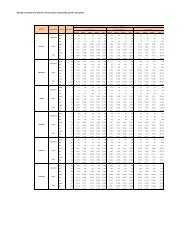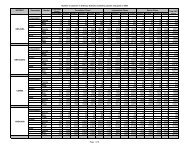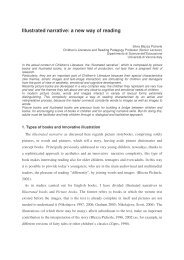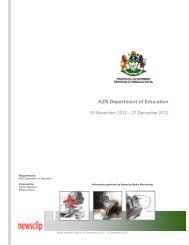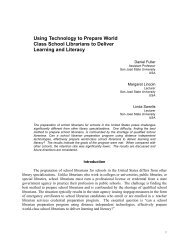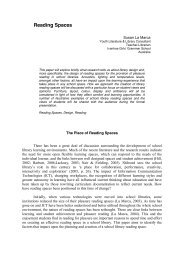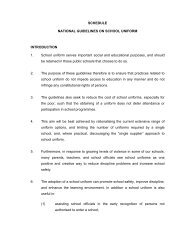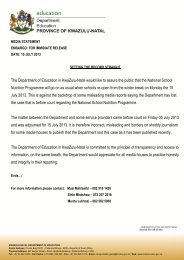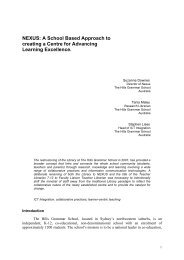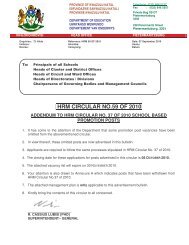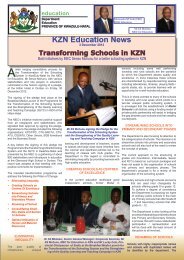School's Report 2012 National Senior Certificate (NSC) Examination
School's Report 2012 National Senior Certificate (NSC) Examination
School's Report 2012 National Senior Certificate (NSC) Examination
You also want an ePaper? Increase the reach of your titles
YUMPU automatically turns print PDFs into web optimized ePapers that Google loves.
2.1 Introduction<br />
KwaZulu-Natal is the largest Province in terms of geographical expansion with a total of 2 869 918<br />
learners in 6256 schools. The institutions are spread over 184 606 square kilometres, and much of<br />
it is rural, with limited infrastructure and the lack of basic infrastructure and communications. These,<br />
together with the dearth of inadequate health and safety provisions, have a profound negative impact<br />
on the nature and quality of curriculum delivery.<br />
There are about 10,2 million people in KwaZulu-Natal. In the context of a curriculum that seeks to<br />
involve parents and the community, this poses challenges for the schooling system. The HIV and<br />
AIDS pandemic prevalent amongst this population adds additional complexities.<br />
The Province has one of the highest illiteracy levels in the country. Of the 5 million people who are<br />
HIV positive in the country, 3 million are in KwaZulu-Natal. The Province also has the highest number<br />
of infant mortality rate and the highest number of Tuberculosis cases.<br />
All of the above mentioned diseases can be easily transmitted from parent to child and this has a<br />
severe impact on the performance of learners.<br />
The majority of schools in urban areas are well resourced with reasonably well qualified educators,<br />
because many of them are attracted to the cities. They also have good infrastructure and reliable<br />
means of communication and transport. In sharp contrast to this, schools in the rural areas are<br />
characterized by poor infrastructure, less reliable transport and communication, with under-qualified<br />
and even un-qualified teachers.<br />
2.2 Schools’ Landscape<br />
KwaZulu-Natal is characterised by extremes in terms of topographical and geographical factors. The<br />
Province’s 6256 schools are categorised as both public and independent schools, in the primary,<br />
secondary and combined categories, as is evident in table A. Public Schools are government<br />
funded schools. Independent Schools are schools that may or may not be funded by government,<br />
and Elsen schools are schools for learners with special educational needs. These are in Table A.<br />
DISTRICT<br />
TABLE A: NUMBER OF SCHOOLS BY DISTRICT, LEVEL AND OWNERSHIP<br />
Independent<br />
Public<br />
Combined Primary Secondary LSEN TOTAL Combined Primary Secondary LSEN TOTAL<br />
AMAJUBA 5 3 1 9 56 133 53 6 248<br />
ILEMBE 3 3 37 274 117 2 430<br />
PINETOWN 24 17 7 48 36 330 133 11 510<br />
SISONKE 5 5 10 132 235 78 2 447<br />
UGU 10 3 3 16 24 328 140 3 495<br />
UMGUNGUNDLOVU 18 17 15 50 45 328 125 9 507<br />
UMKHANYAKUDE 3 2 1 6 15 369 153 3 540<br />
UMLAZI 30 8 12 1 51 16 307 140 19 482<br />
UMZINYATHI 4 2 6 100 288 109 2 499<br />
UTHUKELA 7 4 1 1 13 58 271 117 3 449<br />
UTHUNGULU 7 8 1 1 17 42 427 192 7 668<br />
ZULULAND 5 5 10 91 463 185 3 742<br />
PROVINCE 121 74 40 4 239 652 3753 1542 70 6017<br />
24




